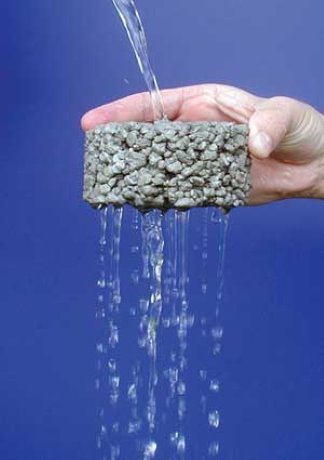The saying “everything old is new again” once again comes in to play in solving a problem that is putting a strain on the use of land resources in municipalities. The financial and land pressures to handle storm water has municipal planners searching for answers.
Opinion
The saying “everything old is new again” once again comes in to play in solving a problem that is putting a strain on the use of land resources in municipalities. The financial and land pressures to handle storm water has municipal planners searching for answers.
The ready mixed concrete industry has a solution with a product called pervious concrete. The product has been referred to as “no fines”, “porous concrete”, “gap graded”, etc. Similar products have been used in North America over the last 50 years in varying applications but generally not as a finished product.
Pervious concrete is defined as a zero slump, open graded material consisting of cement, coarse aggregate, no or little fines, admixtures and water. This is the definition used in the ACI 522R- 06 “Pervious Concrete”. The properties of the concrete vary, but the mix targets air voids of 15% to 25%. It is these properties that provide the performance for storm water management that is in high demand from environmental services of Canadian municipalities.
When it is used as a pavement in conjunction with an underlying stone reservoir, it can capture and store rainwater, allowing it to infiltrate into the subsoil. This has two major benefits: 1) It diverts runoff water from the storm sewers, thereby minimizing the impact on the municipalities’ water treatment requirements and 2) By allowing storm water to infiltrate at source you reintroduce the natural form of water treatment in the soil. The drainability varies but ranges from 80 to 750 L/min/m2 which will handle most storm situations.
Applications include, but are not limited to, parking lots, walkways, landscaping and low volume roads. Depending on the mix design and application, the strength of the pavement can be as high as 28 Mpa.
The use of colours or strips of the pervious pavement in combination with regular concrete provides architectural design options to highlight a landscaped area. Design of the overall system for storm water retention or management will dictate what needs to be underneath the pervious concrete.
If you are designing for a wet or dry retention pond or watering of landscaping, the geotechnical engineer will have to understand the parameters.
Due to the nature and final performance of the product, the placing and curing to achieve the end result becomes critical to the success of the pavement. The concrete mix is placed using some different processes but also allows for standard techniques for finishing the concrete.
A pump cannot be used for placement due to the low slump but a conveyor or bucket or direct placement may be used. The concrete is struck off using a vibratory screed and then rolled. No trowelling to the finish is done, as too much overworking will seal the surface. Curing must follow immediately using plastic sheets. Failure to cure this product will cause the surface to dry and the bond between the aggregate and the paste will not be strong enough to maintain a durable surface.
The low water cement ratio of this product makes curing a must as the mix design will be using up all the available water. This makes it important to wet the base or sub grade prior to placement. In Ontario, the RMCAO will be requiring that contractors be certified to the National Ready Mixed Concrete Association’s Pervious Contractor Certification course in order to assure some level of quality in the placement of the pervious concrete.
Pervious pavement has had a good history of performance in some of the Northern cities in the U.S.
However, with innovative uses of technology there are questions that need to be answered.
Using sand and salt can possibly impair the drainability of the surface. Field history has shown that the drainability has not been impaired substantially and vacuuming annually restores the permeability of the product. Snowplowing may damage the surface depending on how tight the void structure is but field history demonstrates that less snow is retained on the top surface due to the permeability and in the spring thaw, melting snow.
As for freeze thaw, the voids are too large to induce sufficient pressure to break the concrete. Based on the design of the system, sufficient water will drain away, quickly minimizing the conditions for freezing.
In spite of all the anecdotal evidence to support the performance in cold weather, the Cement Association of Canada has entered into an agreement with the University of Waterloo to look at some of the technical issues surrounding this product.
A presentation on this work will be available at Concrete Canada at the Construct Canada show in Toronto in November.
Ross Monsour is the Director of Marketing for the Ready Mixed Concrete Association of Ontario.

Pervious concrete, which among other things allows water to flow through effectively, can play a part in reducing strain on land resources.











Recent Comments
comments for this post are closed